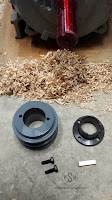

Yes, a new motor was in order for my lathe. The 2hp is good, but when turning large pieces at low speed, it lacks the torque needed. So, here is where the dilemma begins. My first thought was to get a 3 or 5hp motor with the same nameplate speed as my current/previous motor. But, then I have to replace the VFD (brain) with a unit that can handle the increased amperage of the bigger motor. AHHHHH!!!
Good thing I had more than one thought. Not initially realizing that motors come in many different RPM ranges, I proposed my situation to my local surplus dealer. He pointed to a LARGE 2hp motor that is a 870 RPM model. While he didnt say it, I know he was thinking "Thats the one I tried to give you before." DOH!!
So why would I replace my existing 2hp motor with another 2hp motor? The reason is due to the speed rating of each motor. The original is rated at 1700 RPM, while the new one is a 870 RPM unit. The hp rating of a motor is a result of RPM and amperage. This means that the new motor (870 RPM) has twice the torque of other unit! In addition to more torque, Im still retaining similar spindle speeds on the lathe by putting a larger pulley on the new motor. If you cant tell, Im excited! Below are the two motors side by side. They seem to be playing nicely.

This motor came with a key already in the arbor. I thought this was excellent until I had to remove it to accommodate the bushing and pulley style I used. So, here is a quick tip in removing a stuck key. DONT GET A BIGGER HAMMER!!! I used a small plastic face hammer with a tiny screwdriver to try and pop the key out. After not having instant success, I grabbed the penetrating oil. I sprayed down the key and let it soak for a day. The next morning I tried again without success. Now I grabbed a pair of vice grips and a propane torch. After applying heat for maybe a minute I grabbed the key with the vice grips and rapidly tapped the vice grips with the plastic faced hammer. This lifted up the end of the key allowing me to use a small screw driver to pry the key out with little force.




This time, I slid the pulley onto the arbor with the tapped holes facing away from the motor. Next, I slid the bushing in snug to the pulley and pushed the key into place. Now I used the provided screws to pull the bushing into the pulley until tight. I didnt use a torque wrench, I just tightened until it seemed reasonable for the bolts provided.

Its amazing how easily things work when you do it right...
Now to heave this beast onto the lathe. Mind you, the "small" motor was 79 pounds. The new motor is 120 pounds. Thats heavy when you have to hold it 5 inches off the ground and hang it on a few bolts. No, I dont have a hoist or anything that would have made this an easy task. What fun!
Well, other than trowing some new belts on, this upgrade is wrapped up unless you want to hear about wiring... Ok, ok, Ill tell you about wiring the motor. Before I took the original motor off, I tested the new motor. It is surplus after all, and wouldnt I have been ill if Id gone through all that work just to put the original motor back on. So, basically you follow the diagram on the motor for wiring. Use wire nuts and make sure you ground the thing. Ok, done! The heart transplant was a success!











0 komentar:
Posting Komentar